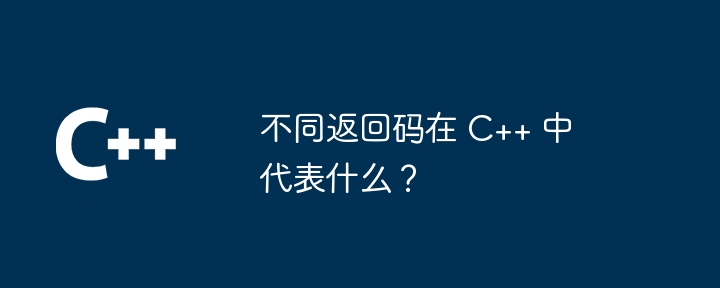不同返回碼在 C++ 中代表什麼?
- 王林原創
- 2024-04-30 15:24:011314瀏覽
在C 中,函數透過回傳碼表示操作結果:常見的回傳碼: 0(成功)、1(錯誤)、-1(檔案操作錯誤)、NULL(空值)、errno(系統錯誤碼)自訂返回碼: 透過枚舉或自訂類型定義,可滿足特定需求。實戰案例: open_and_read_file() 函數使用枚舉類型表示檔案操作的結果,並使用 switch 語句根據回傳碼採取對應操作。

不同回傳碼在C 中的意義
在C 程式中,函數和方法通常會傳回碼來表示運算的結果或狀態。這些返回碼可以是整數、枚舉、布林值或其他自訂類型。理解不同返回碼的含義對於調試和維護程式碼至關重要。
常見的回傳碼
##以下是一些C 中常見的回傳碼:- 0: 表示操作成功執行並完成預期目標。
- 1: 表示操作未成功執行或遇到錯誤。
- -1: 通常表示檔案操作錯誤(例如,開啟或關閉檔案失敗)。
- NULL: 表示空值或空指標。
- errno: 表示由系統函數設定的錯誤代碼(例如,strerror() 函數)。
自訂回傳碼
除了這些常見的回傳碼,您還可以自訂回傳碼以滿足您的特定應用程式需求。這可以透過定義枚舉或建立自己的自訂類型來實現。 例如,在以下枚舉中,我們定義了操作可能產生的不同回傳碼:enum class CustomResultCode {
Success,
InvalidArgument,
ResourceNotFound,
PermissionDenied,
InternalError
};
實戰案例
讓我們來看一個使用自訂返回碼的實戰案例。假設我們有一個函數,該函數嘗試開啟一個檔案並對其進行讀取。以下程式碼示範如何使用枚舉類型來表示操作的結果:#include <iostream>
#include <fstream>
using namespace std;
enum class FileOperationResultCode {
Success,
FileOpenError,
FileReadError,
OtherError
};
FileOperationResultCode open_and_read_file(const string& filename) {
ifstream file(filename);
if (!file.is_open()) {
return FileOperationResultCode::FileOpenError;
}
string line;
while (getline(file, line)) {
cout << line << endl;
}
if (file.bad()) {
return FileOperationResultCode::FileReadError;
}
return FileOperationResultCode::Success;
}
int main() {
string filename;
cout << "Enter the filename: ";
getline(cin, filename);
FileOperationResultCode result = open_and_read_file(filename);
switch (result) {
case FileOperationResultCode::Success:
cout << "File successfully opened and read." << endl;
break;
case FileOperationResultCode::FileOpenError:
cout << "Error opening the file." << endl;
break;
case FileOperationResultCode::FileReadError:
cout << "Error reading from the file." << endl;
break;
case FileOperationResultCode::OtherError:
cout << "An unknown error occurred." << endl;
break;
}
return 0;
}在這個範例中,open_and_read_file() 函數傳回一個 FileOperationResultCode 枚舉值。我們可以使用 switch 語句根據回傳碼執行不同的操作。
以上是不同返回碼在 C++ 中代表什麼?的詳細內容。更多資訊請關注PHP中文網其他相關文章!
陳述:
本文內容由網友自願投稿,版權歸原作者所有。本站不承擔相應的法律責任。如發現涉嫌抄襲或侵權的內容,請聯絡admin@php.cn

